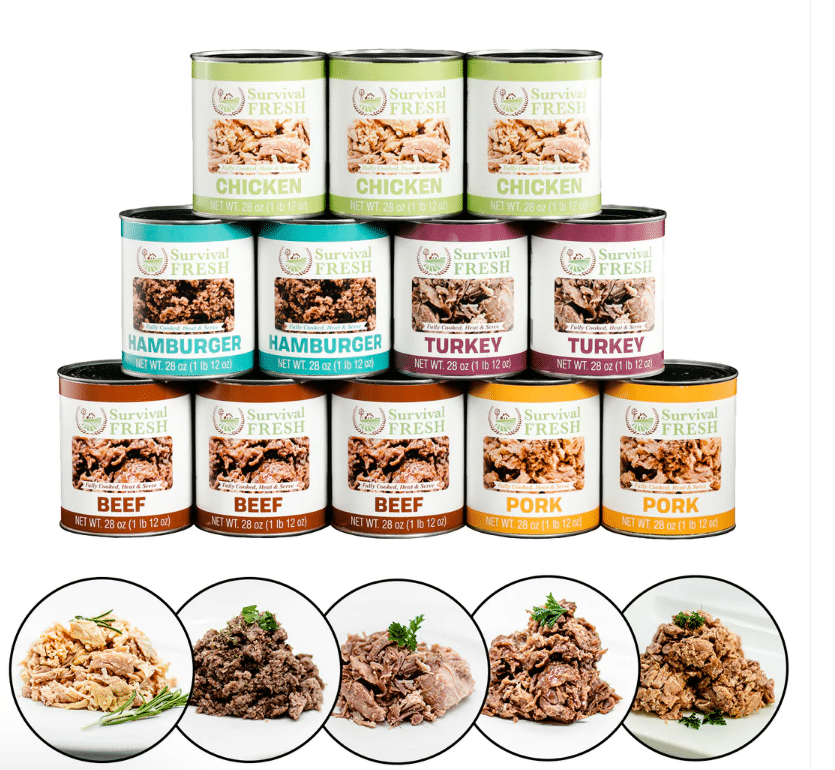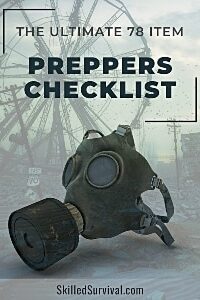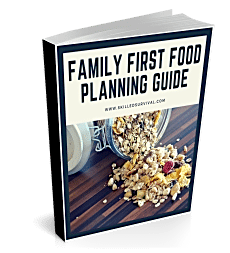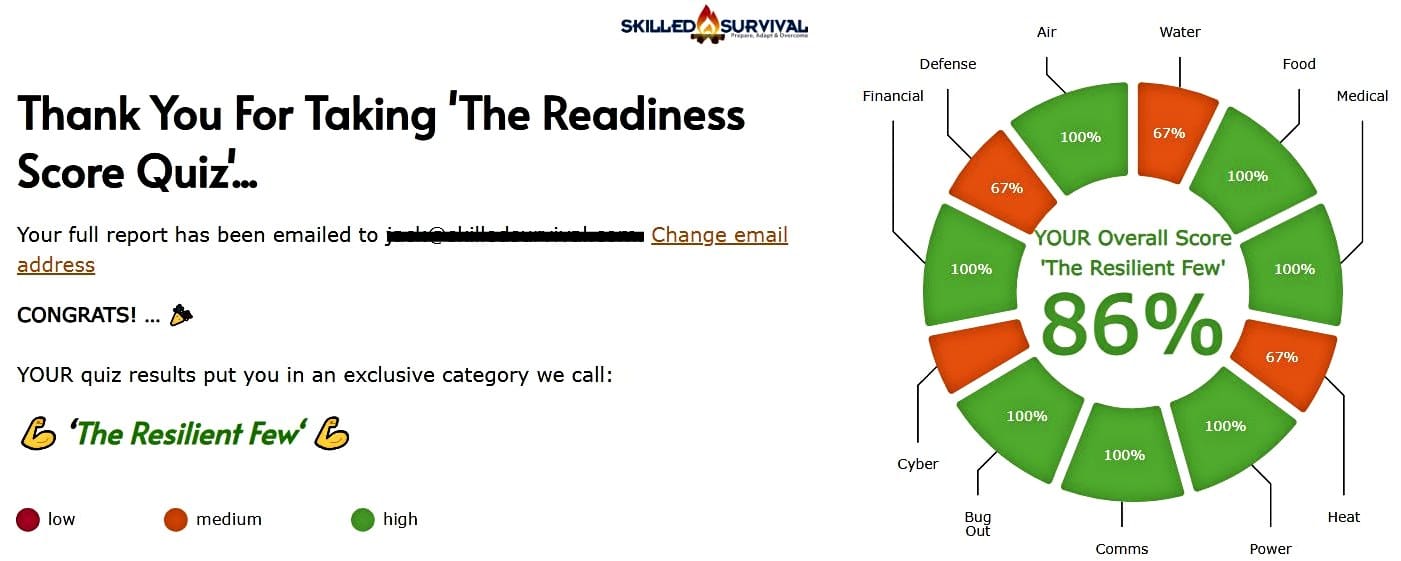
Because, for some reason, they get a bad rap… and that’s a shame because they’re a stockpiling powerhouse.
They turn emergency meals from a stressful scramble into a simple, no-fuss solution. Yet, some people act like stocking up on them is a crime against fine dining.
So let’s cut through the nonsense, bust the stigma, and track down some of the best deals—because when things go sideways, you’ll be glad you have them.
Best Can Meats To Stockpile (Or For A Quick Meal)
Most of us are familiar with conventional canned proteins. You know, the popular ones found on most grocery store shelves (think tuna). But that’s only a fraction of the options available today.
Nowadays, you’ll find a much more extensive range of meat products– especially online. This variety gives you more options for your emergency food planning.
Best Bulk Deal
If you want to stock high-quality canned meat for your emergency supplies with a single order - look no further than Survival Fresh!
First off, they're delicious.
Preppers, campers, and meat lovers have rated them the "best survival food" time and time again.
Not only does it taste great, but Survival Fresh meats have an ultra-long shelf-life of 25 years!
This gives you the confidence to buy in bulk and store them away in your survival pantry.
But how does Survival Fresh last so much longer than any you'd pick up at the grocery store?
The Survival Fresh Meat is first sealed uncooked into the cans, then it's sealed and slow-pressure cooked.
This provides a much longer shelf life.
Grocery store options are lucky to have an 18-month expiration date.
And they're often loaded with fillers, preservatives, and growth hormones.
Only with Survival Fresh Meats will you enjoy all-natural healthy protein with a shelf life of 25 years.
Beef & Pork
Keystone Ground Beef comes in a 14.5 oz can, which is a smart size for a single meal.
It's surprisingly low in sodium for canned beef and high in protein.
So, if you're looking for the base for chili or a meaty spaghetti sauce, this is it.
Hormel Canned Beef Tamales are a great way to break up the monotony of camp food.
Some people think they're a little bland, but that's nothing that hot sauce and a couple of jalapenos can't fix!
These Beef Tamales can make a quick lunch by themselves or an essential part of a more substantial meal with rice and beans.
Armour Corned Beef Hash was a staple of camping breakfasts when I was a kid, and it still brings back that memory.
It's fully cooked and edible right out of the can.
But trying frying it up to "crispy" in a pan over the camp stove makes it far better!
Add a fried egg or two, which is one of the heartiest breakfasts you can find.
Each serving has 22g of protein - but it is also quite high in fat and sodium.
Dak Premium Hams are popular for those looking to serve the whole team.
It's canned meat that's ready to eat straight out of the can.
But the flavor and texture are better if the entire thing is re-heated and glazed in the oven.
They seem to have quite a wide range of prices online, so be sure to watch out for sales.
Hormel Ham has a nice smoky flavor.
These meat chunks are an easy addition to just about any meal.
I like using it with peppers and cheese for a Denver omelet.
But it adds well to soups or ham salad sandwiches as well.
The texture is far better than other canned ham options, but the salt level is a little high.
Draining and rinsing the canned ham with warm water before putting eating it helps cut the salt.
Poultry
Kirkland's Chunk Chicken Breast is one of the most versatile canned meats on the market.
You can add it to just about any recipe that calls for chunks of chicken!
It's an easy addition to sandwiches and pasta and also does well in tacos and chicken salad.
The large pieces also stand up well in a chili or soup, allowing you to add a quick protein.
Valley Fresh Natural Turkey Breast is nothing but white meat turkey breast.
This white turkey meat is perfect for quickly dropping into a turkey soup!
In fact, you'll find the chicken soaking in a seasoned broth.
So it's simple to add some mixed veggies and egg noodles will make a great start towards a single pot meal!
Seafood
Wild Planet Wild Sardines are a great addition to a quick lunch with crackers and cheese.
They're easy to share and packed with protein, calcium, and omega-3 fatty acids.
They're far lower in sodium than many other processed options.
StarKist Solid White Albacore in water provides a lighter flavor and firmer texture.
It's incredibly high in protein and simple to use in sandwiches and casseroles.
There are also plenty of flavored versions of StarKist tuna.
These flavored versions give you lots of different flavors for a great lunch wrap.
Genova Yellowfin Tuna contains both sea salt and heart-healthy extra virgin olive oil.
This blend makes for a bolder flavor and less of the "dry" texture found in water-packed fish.
The yellowfin tuna itself is less fishy than common albacore tuna.
And it's just as high in protein and omega-3s.
There are also no preservatives or additives.
Thus, it makes for a cleaner food option suitable for those with food sensitivities.
It's not cheap, but this is one of the better sources of fish you're likely to find.
Spam & Other Luncheon Meat
Hormel SPAM is "the" meat in a can most of us remember.
There are lots of varieties of SPAM on the market today, but I like the original best.
It's inexpensive and provides a good boost of calories, fat, and protein.
And while it's high in sodium and contains nitrates, most similar products do as well.
As with other processed meats, SPAM is best if you slice it and fry the edges crisp.
Doing so improves both the texture and the flavor.
Vienna Sausages seem to live in the back of everyone's cupboard for years.
At least until you suddenly have a random sausage craving or run out of other options.
There are plenty of recipes to add to stews, omelets, or even pizza.
But I like to slow simmer them in barbecue sauce and serve them as a side dish.

How Meat Is Put Into A Can
Canning IS a technical process, especially for meat. It uses high heat to destroy microorganism. This prevents premature spoilage.
Watch this intriguing video to learn ALL about the process:
↓ How Factories Produce Meat

Want a free 78 item preppers checklist?
Enter your email below to instantly download this Complete Checklist PDF. No purchase necessary. 👇 👇Why You Should Stockpile Long-Shelf Life Meat
There are three reasons to choose canned over fresh:
- Sterilization
- Preservation
- Convenience
Let’s discuss all three.
1. Sterilization
Most are commercially sterilized in a factory setting. This sterilization process provides consistent products with a nearly indefinite storage life.
Note: This is true as long as the can remains intact and stored at stable “room temperatures”.
2. Preservation
A long shelf life is important for maintaining a stable food supply. And room temperature storage means NOT rely on refrigeration!
So even if the power goes out, these goods will remain safe to consume. This is especially true if you push past the “best by” dates!
3. Convenience
They’re usually “pre-cooked” AND “pre-chunked.”
Allowing you to:
- open
- dump
- and mix
This makes mealtime preparation a breeze.
↓ Types Of Canned Proteins

Want a free family-first food planning guide?
Enter your email below to instantly download this Complete Guide PDF. No purchase necessary. 👇 👇How To Cook Meat From A Can
First, many people have a low opinion of cooking protein out of a can. But that’s a shame.
These shelf-stable pantry staples have been around for hundreds of years.
Back in the 17th century, it was called potted meat. And it will bring a lot of value to a meal with minimal time and effort.
Since they’re “pre-cooked,” they’re great for:
- Slow-cooked recipes (such as soups)
- Quick finger food snacks (especially sausages)
- Lunchtimes staples (such as chicken salad sandwiches)
- They fry well with eggs and potatoes in a hearty breakfast hash or a quick omelet.
- Chicken chunks easily drops into any pasta casserole and makes pot pies quick on a weeknight.
- Heck, try breaking out some southwestern spices. This combination works well to make your favorite Mexican dishes—yummy dishes such as tacos, burritos, and quesadillas.
- Have you ever heard of “SPAM musubi”? Check it out if you want to change your preconceived notion of what you can do
So as you see, there’s no shortage of ways to incorporate protein into your cooking process.
↓ How To Cook Government Meat

Want a free 78 item preppers checklist?
Enter your email below to instantly download this Complete Checklist PDF. No purchase necessary. 👇 👇Best Features To Look For
Package Size Vs. Portion Size
Packaging, and portion size matter.
A sizeable canned ham may be the best deal per ounce. But if you’re planning meals for one, managing the leftovers from such a large portion may not be workable.
Large sizes are even more of a challenge at a campsite.
Similarly, bulky ones make for heavy packs on expeditions.
Instead, with smaller packages, you distribute them among the group to share the load. But this also increases the amount of packaging material used. Which adds up and is a waste of weight.
And to make things more complex, they often include gravy or broth. These additions count towards the weight of the container – meaning less protein. These ingredients act as a filler.
Hence, they reduce the amount of actual amount of protein in each container. So be sure to consider this in your meal and emergency food planning.
You may need to increase the serving size if broth or gravy makes up a significant portion.
For example:
A 6oz label may only include 4oz of actual proteins!
When you’re planning meals, it’s worth reviewing recipes ahead of time to see how far they’ll go. The last thing you want in an emergency is to be one serving short. So choosing the right size package is a balancing act.
I recommend creating meal plans that use the entire amount instead of partials. This strategy leaves everyone well-fed and produces fewer leftovers.
High Sodium Content
Most proteins in a can include a lot of salts.
Why? Because salt creates an inhospitable environment for bacteria. But this is a real challenge for anyone who’s trying to stick to a low-sodium diet.
Also, the ‘spice blends” in many flavored versions contain even more salt. To offset this, only add a small amount of salt (or non at all) elsewhere in the recipe. But you may want to look for low-sodium versions of your favorites. Or avoid any pre-flavored varieties if possible.
Preservatives and Fillers
As already mentioned, this food type usually begins the preservation process with salt. But nitrites and nitrates are other common preservatives found in processed meats.
Manufacturers use this tactic to increase shelf-life. But these preservatives cause severe food allergies for some.
So some manufacturers use sodium ascorbate instead of nitrites.
Unfortunately, there’s no substitute for “some” level of nitrates. It’s part of the meat curing process.
Shelf Life
Shelf life is a significant selling factor. So it’s worth knowing how long each type will last.
Using proper storage practices, you’ll help your canned protein remain edible even longer. A dark, dry pantry with temperatures under 75deg year-round is best.
You should also inspect your goods regularly. Use up or discard any dented, rusted, or leaking ones immediately. But, if properly stored, these meats are generally suitable for up to 5 years past the “Best By” date.
But as with all emergency food, it’s best to rotate your goods periodically.
I recommend using a “first-in, first-out” inventory strategy. And the best way to do this is with first-in, first-out storage racks. This strategy ensures you don’t leave any on the back of the shelf longer than those in front.
Go here to read more about storage racks and organization techniques.
Cans Vs. Jars Vs. Foil Packets
For many years there were only two options:
- Glass jars and
- Metal cans
Glass jars are a popular choice for DIY canners. But industrial options turned to metal long ago.
Modern “tin cans” no longer use tin. But instead use steel lined with food-safe plastic.
This structure keeps the food inside from directly contacting the metal. And thus, it prevents “off” tastes and corrosion, which may lead to leakage. But both of these technologies rely on a more robust container.
In the past 20 years, more manufacturers have begun using Mylar foil packets.
These specialty packets are capable of withstanding pressure and heat of processing.
These packages are far lighter than traditional metal and glass. They also take up less space in a pantry. This newer process improves food quality and reduces filler.
Some are even resealable to hold your leftovers. But resealing this way won’t be sterile, so keep it refrigerated.

Want a free family-first food planning guide?
Enter your email below to instantly download this Complete Guide PDF. No purchase necessary. 👇 👇How To Can Meat At Home (DIY Canned Meat)
Many of us have tried canning fruits and vegetables at home. But we often hear you shouldn’t can protein yourself.
And while it’s wise to be cautious, it IS possible. If you have the right equipment.
The critical piece of equipment is a Pressure Canner.
Why? Because meat is a low-acid food, which makes it an ideal environment for bacteria to grow.
- Because water bath canning for vegetables will only reach temperatures of 212deg.
- But a pressure canner easily reaches temperatures upwards of 250deg.
That’s a high enough temperature to kill all bacteria and spores – even in meats. So, if you’re going to try canning some yourself, plan on getting a pressure cooker. And follow all instructions to a T.
Many wild game cooking websites have recipes for various types.
The National Center for Home Food Preservation is another excellent resource.
NEVER skip any cleaning and preparation steps; take them seriously. You must begin with sanitized jars and clean utensils to prevent bacterial contamination. Take extreme care when prepping meat as well.
Because leaving bits of shell or bone or extra fats all affect the quality of the final product.
↓ Canning Proteins (Super Easy Raw Pack)
Final Thoughts
Whether it’s slices of ham or chunks of roast beef. Don’t allow the image of a blah tuna noodle casserole turn you off.
The variety of meats and seafood on the market deserves a second chance.
They add a quick dose of high-quality protein to any meal and adapt well into many everyday recipes. They also provide long-term storage without needing to rely on refrigeration.
If you want to be part of the resilient few, read up on home canning and save that bounty for leaner times.
Take it from me:
There are plenty of ways to incorporate these meats into your survival foods. And once you give it a try, you’ll be hooked you for life! It’s one of the best meats for preppers for stocking your pantry…

Prepare, Adapt & Overcome,
P.s. - I just found out 2 out of 3 Americans don’t feel prepared for a 3 day disaster!!!
I guess this goes to show how modern society continues to embrace ‘living a fragile life.’ What’s crazy is… it’s so easy to fix.
To make sure YOU have the basics, watch our FREE training on “10 Simple Steps To Basic Preparedness” that shows you HOW.
Nothing crazy here… this isn’t doomsday prepping... just the basics every responsible adult should have before a disaster strikes.Why You Can Trust Skilled Survival...
Go here now to review a full breakdown of:
- Who We Are
- Our Credentials
- Our Mission
- & Product Recommendations...
Here are a few highlights of our teams credentials & certifications:
- Certified Member of a Mountain Search & Rescue Organization
- Plant Emergency & Safety Leader for a Major Food Manufacturer
- Member of the 10TH Mountain Division Hut Association
- Certifications: Avalanche 1, WFR, CPR
- Official Gear Tester for Numerous Outdoor Gear Companies
- Countless Multiday Backpacking trips into Remote Wilderness
- Bachelor's Degree In Mechanical Engineering
- Bachelor's Degree In Civil Engineering
- Bachelor's Degree In Biomedical Engineering
"It takes 20 years to build a reputation and five minutes to ruin it." - Warren Buffett
We're fully aware that trust is NOT something you GET but is EARNED.
And we'll continue to earn YOUR trust through our forthright and honest approach with each new Blog Post, Guide & Product we create...
P.s - I just took this FREE 60-second 'Readiness Score Quiz'👇
AND... I've still got a few gaps in my preps...🤔 But at least, I'm not part of 'The Fragile Masses'. 👍 Find out where YOU stand by answering a few questions...

Recommended Reading
Best Powdered Milk With An Insanely Long Shelf Life
Not all powdered milk is created equal. We've uncovered all the best deals and share tactics on how to significantly extend it's shelf life.
Best Grain Mills To Grind Your Own Grains At Home
Need help finding the best grain mill for you? We show you the key features to look for (and avoid) - plus the 9 best on the market today
Best Powdered Eggs (& Deals) On The Market Right Now
The best powdered eggs are tasty, affordable, long lasting and worth buying! In this guide, we review the best ones to make your search easy.
Best Canned Bread (& Mixes) With Insanely Long Shelf Lives
The best canned breads are tasty, affordable, long lasting and worth buying! In this guide, we review the best ones on the market to make your search easy.
Peanut Butter Powder: Best Ones With Insanely Long Shelf Life
Best Peanut Butter Powder for long term protein storage - 1. Ready Hour 2. Augason Farms 3. Legacy Foods 4. PBfit 5. Naked PB 6. PB2 Pure...
Best Honey Powders With An Insanely Long Shelf Life
Looking for the best honey powder for emergencies? We break down the best deals and how long powdered honey can last on your shelf.



















